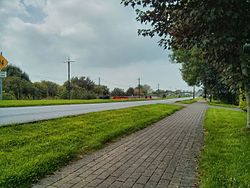Pollagh
|
Pollagh Pollach
|
||
|---|---|---|
| Town | ||
 |
||
|
||
| Location in Ireland | ||
| Coordinates: 53°16′36″N 7°42′29″W / 53.2767°N 7.7081°WCoordinates: 53°16′36″N 7°42′29″W / 53.2767°N 7.7081°W | ||
| Country | Ireland | |
| Province | Leinster | |
| County | Offaly | |
| Elevation | 68 m (223 ft) | |
| Population (2011) | ||
| • Urban | 800 | |
| Time zone | WET (UTC+0) | |
| • Summer (DST) | IST (WEST) (UTC-1) | |
| Irish Grid Reference | N185250 | |
Pollagh also spelled Pullough (Irish: Pollach) is a village in County Offaly, Ireland, located in the midlands of Ireland. The name Pollagh comes from the Irish Poll ach, literally meaning expansive hole, but practically meaning "broad expanse of shallow water". It is a rural village on the Grand Canal and lies between Ferbane and Tullamore ranging from lemonaghan cross/dernagun to heathfield/oughter including derryneavy/turraun, the cush and the canal line. Much of the surrounding area is bogland, and is used to produce fossil fuels such as peat turf. The River Brosna flows close to the village. The Grand Canal was used for transporting peat and bricks produced in the area. Pollagh benefited from the canal in earlier years when it brought investment and employment from Bord na Móna, and it is now an important part of the tourist attraction. Pollagh is also known for its church, particularly its bog oak altar and stained glass windows, designed by the Harry Clarke Studios.
The name "Pullough" or "Pollagh" comes from the Irish words meaning "place of holes", a reference to the boggy landscape. Although people undoubtedly lived in this area throughout history,the first substantial settlements occurred after 1771, when a new law banned brick-making near Dublin. This stimulated the brick-making industry in the midlands. Pullough’s unique yellow bricks, made from blue silt clay, were particularly prized. At first, the town’s bricks were placed on rafts on the River Brosna and pulled, by hand, to Ferbane. Then, when the Grand Canal arrived in Pullough, it became possible to ship Pullough’s bricks throughout Ireland. Huge loads of Pullough brick passed beneath the arch of the Plunkett Bridge, which was finished in 1809. In 1837, 12 brickyards lined the route of the Grand Canal through Pullough and Rahan. By the end of the 19th century, there were 14 brickyards in Pullough alone. Each brickyard would have produced about 5,000 bricks a day, and another 200 "dog bricks" – extra bricks made because wild dogs almost always walked on the new raw bricks at night and ruined some of them. Lured by the brick-making industry, so many families moved to Pullough that in 1872, local authorities constructed the Pullough National School. The end of the 19th century also saw the birth of a new industry in Pullough. In the 1890s, Kieran Farrelly began a peat-harvesting business at Turraun Bog. By 1900, he had around 100 hectares (240 acres) of bogland under development and had built a factory to process the peat. After a flood destroyed Farrelly’s factory in 1903, he was forced to emigrate to America. The Turraun Peat Company was bought by a Welshman, Sir John Purser Griffith, in 1910. Griffith drained Turraun bog. Then, in the 1920s, he built a peat-operated power station that produced 4,000 long tons (4,100 t) of sod turf each year. This turf was transported to Dublin via the Grand Canal. In 1936, the Turf Development Board purchased the company. During the fuel crisis of the Second World War, it opened Turraun Camp, where hundreds of workers from all over the country lived while they harvested peat. Shipped to Dublin via the Grand Canal, the peat was sold, from huge ricks, in the Phoenix Park. The Turf Development Board also experimented with the use of peat as a petrol substitute. Today, two walls at Turraun Wetlands are all that remain of this charcoal factory. In 1946, Bord na Móna was founded to oversee further development of the bogs and utilisation of peat. At Turraun, the production shifted from sod to milled peat. Bord na Móna became the major employer in Pullough. Turraun supplied high-density peat for the Ferbane Power Station until it was decommissioned in 2002.
...
Wikipedia


